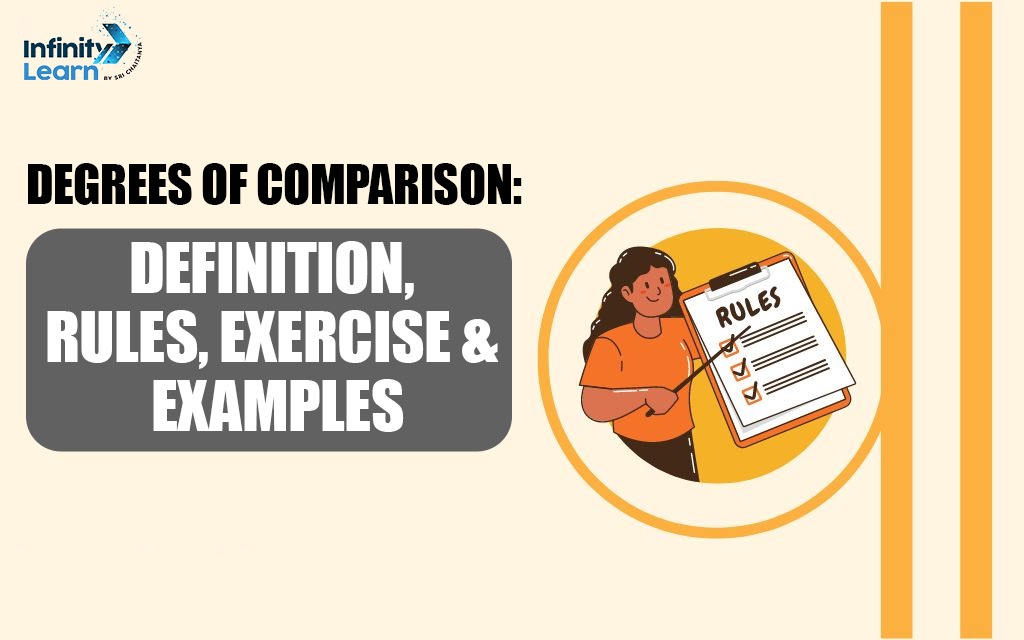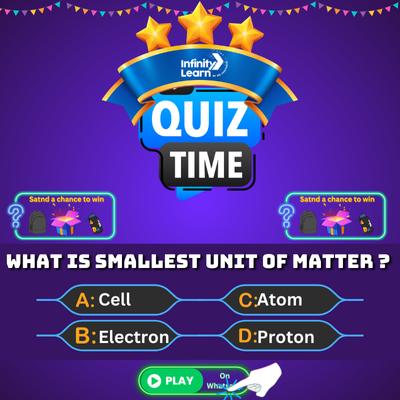Table of Contents
Degrees of Comparison: Degrees of Comparison are a key part of English grammar. They help us compare the qualities of people, places, or things. They help show if something has the same quality, more of it, or the most. There are three types: positive, comparative, and superlative. The positive degree shows a quality (e.g., tall). The comparative degree compares two things (e.g., taller).
The superlative degree compares three or more (e.g., tallest). Using these correctly makes your writing clearer. This guide will explain the rules, give simple examples, and include a helpful Degrees of Comparison worksheet with answers. Learning degrees of comparison is easy with the right practice!
What is Degrees of Comparison?
In English grammar, degrees of comparison are forms of adjectives or adverbs used to compare one noun or pronoun with another based on a similar quality. According to the Oxford Learner’s Dictionary, the degree of comparison is “the form of an adjective or adverb that shows whether something has more or the most of a particular quality.”
The Cambridge Dictionary explains it as “the three forms of adjectives or adverbs that show increasing or decreasing intensity: positive, comparative, and superlative.” These degrees help us describe and compare the qualities of people, objects, or places in a sentence. By using the positive, comparative, and superlative degrees, we can express differences and similarities in a clear and structured way.
These degrees help make sentences clearer and more meaningful by showing how one noun differs in quality from another. Learning the rules of degrees of comparison is important for using adjectives correctly in writing and speech.
Types of Degrees of Comparison in English Grammar
In English grammar, degrees of comparison are used to compare the qualities of nouns or pronouns using adjectives or adverbs. There are three main types of degrees of comparison: Positive, Comparative, and Superlative. Each one shows the level or intensity of a quality and helps in expressing comparisons clearly.
1. Positive Degree
The positive degree is the base form of an adjective or adverb. It is used when we talk about the quality of a single person or thing, without comparing it to others.
Example
- This house is big.
- She is smart.
2. Comparative Degree
The comparative degree is used to compare two people, places, animals, or things. Most adjectives form the comparative by adding “-er” or using “more” before the word.
Example:
- This house is bigger than that one.
- She is more intelligent than her sister.
3. Superlative Degree
The superlative degree is used to compare three or more nouns. It shows the highest or lowest degree of quality. We usually form it by adding “-est” or using “most” before the adjective.
Example:
- This is the biggest house on the street.
- She is the most talented student in the class.

Rules for Using Degrees of Comparison in English Grammar
When you’re writing or speaking in English, it’s important to use degrees of comparison correctly. These rules help you form and apply the positive, comparative, and superlative forms of adjectives and adverbs the right way. Let’s go through each type and understand how to use them properly.
Rules for the Positive Degree
What it means: The positive degree shows a quality without comparing it to anything else.
How to form it: Use the base form of the adjective or adverb.
When to use: When you describe one person or thing without comparison.
Example:
- She is kind.
- This cake tastes sweet.
Rules for the Comparative Degree
The comparative degree helps you compare two people, animals, or things. How you form it depends on the number of syllables in the adjective.
🔹 One-syllable adjectives:
Rule: Add “-er” to the word.
Example:
- small → smaller
- fast → faster
🔹 Two-syllable adjectives ending in “y”:
Rule: Change the “y” to “i” and add “-er.”
Example:
- happy → happier
- busy → busier
🔹 Adjectives with two or more syllables (not ending in “y”):
Rule: Use “more” or “less” before the adjective.
Example:
- careful → more careful
- interesting → less interesting
🔹 Irregular comparative forms:
Rule: Some adjectives change form completely.
Example:
- good → better
- bad → worse
Use the comparative degree when comparing two nouns.
Example:
- This book is more interesting than the last one.
- He runs faster than his friend.
Rules for the Superlative Degree
Use the superlative degree when comparing three or more nouns. It shows the highest or lowest level of a quality.
🔹 One-syllable adjectives:
Rule: Add “-est” to the adjective.
Example:
- tall → tallest
- cold → coldest
🔹 Two-syllable adjectives ending in “y”:
Rule: Change “y” to “i” and add “-est.”
Example:
- happy → happiest
- easy → easiest
🔹 Adjectives with two or more syllables:
Rule: Use “most” or “least” before the adjective.
Example:
- beautiful → most beautiful
- comfortable → least comfortable
🔹 Irregular superlative forms:
Rule: Some adjectives don’t follow normal patterns.
Example:
- good → best
- bad → worst
Use the superlative when comparing three or more things.
Example:
- She is the smartest student in the class.
- This is the most expensive item on the menu.
Special Grammar Rules and Helpful Tips
Avoid double comparatives and superlatives
Rule: Don’t use “more” or “most” with adjectives that already use “-er” or “-est.”
Incorrect: more smarter, most fastest
Correct: smarter, fastest
Follow the same rules for adverbs
Rule: Adverbs that end in “-ly” use “more” or “most.”
Example:
- quickly → more quickly, most quickly
- happily → more happily, most happily
Know your absolute adjectives
Rule: Adjectives like perfect, unique, complete, or empty already describe an absolute state. They don’t have comparative or superlative forms.
Incorrect: more perfect, most unique
Correct: perfect, unique
Always consider the context
Tip: Choose the degree of comparison based on the number of things you’re comparing. Use clear sentence structure to make the comparison logical and easy to understand.
Also Check: Degrees of Comparison Worksheet
What Are Degrees of Comparison in Adjectives?
Degrees of Comparison refer to the forms adjectives take to compare one, two, or more nouns.
There are three degrees:
| Degree | Usage | Example |
|---|---|---|
| Positive | Describes one thing or person (no comparison) | Riya is tall. |
| Comparative | Compares two things or people | Riya is taller than Meena. |
| Superlative | Compares three or more things or people | Riya is the tallest girl in class. |
Types of Adjectives by Comparison
1. Regular Adjectives
Formed by adding -er / -est or using more / most
| Positive | Comparative | Superlative |
|---|---|---|
| small | smaller | smallest |
| tall | taller | tallest |
| bright | brighter | brightest |
2. Adjectives with ‘More’ and ‘Most’
Used with adjectives of two or more syllables
| Positive | Comparative | Superlative |
|---|---|---|
| beautiful | more beautiful | most beautiful |
| intelligent | more intelligent | most intelligent |
| difficult | more difficult | most difficult |
These do not follow any fixed rule.
| Positive | Comparative | Superlative |
|---|---|---|
| good | better | best |
| bad | worse | worst |
| far | farther/further | farthest/furthest |
Rules for Forming Degrees of Comparison
➤ For one-syllable adjectives:
Add -er and -est
- fast → faster → fastest
➤ For adjectives ending in e:
Just add -r and -st
- large → larger → largest
➤ For adjectives ending in consonant + vowel + consonant:
Double the final consonant
- big → bigger → biggest
➤ For adjectives ending in y (preceded by consonant):
Change y to i and add -er / -est
- happy → happier → happiest
➤ For two or more syllables:
Use more and most
- careful → more careful → most careful
Degrees of Comparison 100 Examples
| Positive | Comparative | Superlative |
|---|---|---|
| small | smaller | smallest |
| big | bigger | biggest |
| fast | faster | fastest |
| tall | taller | tallest |
| short | shorter | shortest |
| young | younger | youngest |
| old | older | oldest |
| bright | brighter | brightest |
| dark | darker | darkest |
| easy | easier | easiest |
| happy | happier | happiest |
| sad | sadder | saddest |
| strong | stronger | strongest |
| weak | weaker | weakest |
| rich | richer | richest |
| poor | poorer | poorest |
| thin | thinner | thinnest |
| fat | fatter | fattest |
| clean | cleaner | cleanest |
| dirty | dirtier | dirtiest |
| clever | cleverer | cleverest |
| brave | braver | bravest |
| nice | nicer | nicest |
| kind | kinder | kindest |
| sweet | sweeter | sweetest |
| bitter | more bitter | most bitter |
| loud | louder | loudest |
| quiet | quieter | quietest |
| hot | hotter | hottest |
| cold | colder | coldest |
| dry | drier | driest |
| wet | wetter | wettest |
| wise | wiser | wisest |
| lazy | lazier | laziest |
| busy | busier | busiest |
| pretty | prettier | prettiest |
| ugly | uglier | ugliest |
| bad | worse | worst |
| good | better | best |
| far | farther/further | farthest/furthest |
| much | more | most |
| many | more | most |
| little | less | least |
| important | more important | most important |
| beautiful | more beautiful | most beautiful |
| careful | more careful | most careful |
| helpful | more helpful | most helpful |
| honest | more honest | most honest |
| useful | more useful | most useful |
| harmful | more harmful | most harmful |
| exciting | more exciting | most exciting |
| boring | more boring | most boring |
| interesting | more interesting | most interesting |
| popular | more popular | most popular |
| famous | more famous | most famous |
| difficult | more difficult | most difficult |
| dangerous | more dangerous | most dangerous |
| careful | more careful | most careful |
| cheerful | more cheerful | most cheerful |
| lucky | luckier | luckiest |
| unlucky | unluckier | unluckiest |
| polite | more polite | most polite |
| rude | ruder | rudest |
| simple | simpler | simplest |
| complex | more complex | most complex |
| narrow | narrower | narrowest |
| wide | wider | widest |
| early | earlier | earliest |
| late | later | latest |
| tall | taller | tallest |
| deep | deeper | deepest |
| shallow | shallower | shallowest |
| slow | slower | slowest |
| healthy | healthier | healthiest |
| sick | sicker | sickest |
| angry | angrier | angriest |
| tired | more tired | most tired |
| faithful | more faithful | most faithful |
| helpful | more helpful | most helpful |
| exciting | more exciting | most exciting |
| sad | sadder | saddest |
| warm | warmer | warmest |
| cool | cooler | coolest |
| thin | thinner | thinnest |
| fat | fatter | fattest |
| expensive | more expensive | most expensive |
| cheap | cheaper | cheapest |
| noisy | noisier | noisiest |
| calm | calmer | calmest |
| rich | richer | richest |
| strong | stronger | strongest |
| neat | neater | neatest |
| dirty | dirtier | dirtiest |
| lucky | luckier | luckiest |
| clumsy | clumsier | clumsiest |
| smart | smarter | smartest |
| cool | cooler | coolest |
| sharp | sharper | sharpest |
Degrees of Comparison Chart: Positive, Comparative & Superlative Degrees
One-Syllable Adjectives with Doubled Final Consonants
| Positive | Comparative | Superlative |
|---|---|---|
| big | bigger | biggest |
| hot | hotter | hottest |
| thin | thinner | thinnest |
| fat | fatter | fattest |
| sad | sadder | saddest |
| red | redder | reddest |
| mad | madder | maddest |
| wet | wetter | wettest |
| dim | dimmer | dimmest |
| flat | flatter | flattest |
| fit | fitter | fittest |
| glad | gladder | gladdest |
| grim | grimmer | grimmest |
| slim | slimmer | slimmest |
One-Syllable and Some Two-Syllable Adjectives with Regular Formation
| Positive | Comparative | Superlative |
|---|---|---|
| tall | taller | tallest |
| small | smaller | smallest |
| fast | faster | fastest |
| short | shorter | shortest |
| long | longer | longest |
| young | younger | youngest |
| kind | kinder | kindest |
Two-Syllable Adjectives Not Ending in ‘y’
| Positive | Comparative | Superlative |
|---|---|---|
| careful | more careful | most careful |
| honest | more honest | most honest |
| pleasant | more pleasant | most pleasant |
| awkward | more awkward | most awkward |
| active | more active | most active |
| massive | more massive | most massive |
Two-Syllable Adjectives Ending in ‘y’
| Positive | Comparative | Superlative |
|---|---|---|
| happy | happier | happiest |
| pretty | prettier | prettiest |
| noisy | noisier | noisiest |
| lazy | lazier | laziest |
| cozy | cozier | coziest |
| friendly | friendlier | friendliest |
Multi-Syllable Adjectives Using “More” and “Most”
| Positive | Comparative | Superlative |
|---|---|---|
| beautiful | more beautiful | most beautiful |
| interesting | more interesting | most interesting |
| comfortable | more comfortable | most comfortable |
| successful | more successful | most successful |
| generous | more generous | most generous |
| important | more important | most important |
Irregular Adjectives with Unique Forms
| Positive | Comparative | Superlative |
|---|---|---|
| good | better | best |
| bad | worse | worst |
| far | farther | farthest |
| little | less | least |
| many | more | most |
| well | better | best |
Degrees of Comparison – Examples in Sentences
| Positive Degree | Comparative Degree | Superlative Degree |
|---|---|---|
| Rahul is kind. | Rahul is kinder than Ankit. | Rahul is the kindest person in our class. |
| This soup is tasty. | This soup is tastier than the one we had last week. | This soup is the tastiest dish on the menu. |
| Neha’s handwriting is neat. | Neha’s handwriting is neater than Reema’s. | Neha has the neatest handwriting in the entire batch. |
| The bike is fast. | This bike is faster than the scooter. | This bike is the fastest vehicle in our garage. |
| My garden looks fresh. | My garden looks fresher than it did yesterday. | My garden is the freshest in the neighborhood. |
| He is brave. | He is braver than his younger brother. | He is the bravest soldier in the unit. |
| This puzzle is tricky. | This puzzle is trickier than the previous one. | This puzzle is the trickiest in the book. |
| The beach was calm. | The beach was calmer than the city. | It was the calmest place we visited during the trip. |
| The classroom is bright. | This classroom is brighter than the one upstairs. | This is the brightest classroom in the school. |
| The exam was hard. | This exam was harder than the last one. | That was the hardest exam I’ve ever taken. |
| This cat is playful. | This cat is more playful than the dog. | This cat is the most playful pet in the shelter. |
| Her story is creative. | Her story is more creative than mine. | Her story is the most creative in the magazine. |
| The roads are wide. | These roads are wider than those in the village. | These roads are the widest in the region. |
| That movie is funny. | That movie is funnier than the one we saw last night. | That movie is the funniest I’ve seen all year. |
| This jacket is warm. | This jacket is warmer than yours. | This is the warmest jacket in the store. |
| My father is strong. | My father is stronger than my uncle. | My father is the strongest in our family. |
| Her idea is good. | Her idea is better than mine. | Her idea is the best of all we received. |
| The floor is clean. | This floor is cleaner than the kitchen floor. | This is the cleanest floor in the house. |
| The mountain is high. | This mountain is higher than the one we climbed last year. | Mount Everest is the highest mountain in the world. |
| That athlete is fast. | That athlete is faster than his teammate. | He is the fastest sprinter in the tournament. |
| The book is thick. | This book is thicker than the English textbook. | This is the thickest book in my collection. |
| My mother is helpful. | My mother is more helpful than my aunt. | My mother is the most helpful person I know. |
| This phone is smart. | This phone is smarter than the old model. | This is the smartest phone available in the market. |
| The cake is soft. | This cake is softer than the one we baked last week. | This cake is the softest I’ve ever tasted. |
Degrees of Comparison Worksheets
Part A: Multiple Choice Questions (MCQs)
1- Choose the correct form of the adjective or adverb.
This is the __________ movie I’ve ever seen.
a) more boring
b) boring
c) most boring
d) bored
She runs __________ than her sister.
a) quick
b) more quickly
c) quickest
d) quicker
Among all the students, Ron is the __________ in mathematics.
a) good
b) better
c) best
d) most good
The room on the left is __________ than the one on the right.
a) large
b) larger
c) largest
d) more large
Which sentence is grammatically correct?
a) He is the more clever of the two.
b) He is cleverest in his family.
c) He is more clever than his brother.
d) He is the most cleverer in class.
Part B: Fill in the Blanks
2- Use the correct degree of comparison.
- My car is __________ (fast) than yours.
- That was the __________ (bad) mistake you could make.
- This book is __________ (interesting) than the one I read last week.
- She is __________ (beautiful) girl in the competition.
- Iron is __________ (strong) than copper.
Part C: Error Spotting / Sentence Correction
- This is the more exciting game of the season.
- He is the better player between the two.
- I am most happiest when I’m traveling.
- She is the bestest singer I know.
- This is the most quickest route to the airport.
- Find and correct the errors in each sentence.
Part D: Sentence Transformation
Rewrite each sentence as directed.
Tina is tall. Rita is taller.
→ Combine using a comparative degree.
This dress is the most elegant in the store.
→ Rewrite using a positive degree.
No other player is as skilled as Leo.
→ Rewrite using a superlative degree.
The blue bag is cheaper than the red one.
→ Rewrite using a positive degree.
John is more hardworking than Sam.
→ Rewrite using a superlative form.
Part E: Short Answer / Creative Application
- Write 5 adjectives and their positive, comparative, and superlative forms.
- Describe your favorite place using at least 3 different degrees of comparison.
- Why is it incorrect to say “more better” or “most fastest”? Explain briefly.
- Create a mini paragraph (4–5 lines) using all three degrees of comparison correctly.
- Choose a famous person and compare them with another using at least 3 comparative adjectives.
📝 Bonus IELTS-style Question (Writing Task 1)
26. Some people say cities are more developed than villages, while others prefer rural life due to its simplicity.
→ Write a short paragraph (100–120 words) comparing city and village life using various degrees of comparison.
Degrees of Comparison FAQs
What is degree of comparison with example?
The degree of comparison is a grammar rule used to compare the quality of two or more nouns using adjectives or adverbs. There are three forms: Positive: Describes one thing. (e.g., She is kind.) Comparative: Compares two things. (e.g., She is kinder than her sister.) Superlative: Compares three or more things. (e.g., She is the kindest of all.)
What are the degrees of comparison for Class 7?
For Class 7 students, the degrees of comparison include: Positive: Describes without comparing. (e.g., The cat is soft.) Comparative: Compares two things. (e.g., This cat is softer than that one.) Superlative: Compares more than two. (e.g., This is the softest cat of all.) Students learn to form, identify, and use these degrees correctly in sentences.
How to change degrees of comparison?
To change degrees of comparison, follow these steps: Identify the degree used in the sentence. Convert it to another degree using grammar rules. Examples: Positive to Comparative: She is tall. → She is taller than her friend. Comparative to Superlative: She is taller than her friend. → She is the tallest in her class. Use than for comparatives and the before superlatives.
What is positive degree of comparison?
The positive degree describes a noun without comparing it to others. It shows a simple quality or condition. Example: This flower is beautiful. There is no comparison made here — just a statement of the quality using the adjective in its base form.








